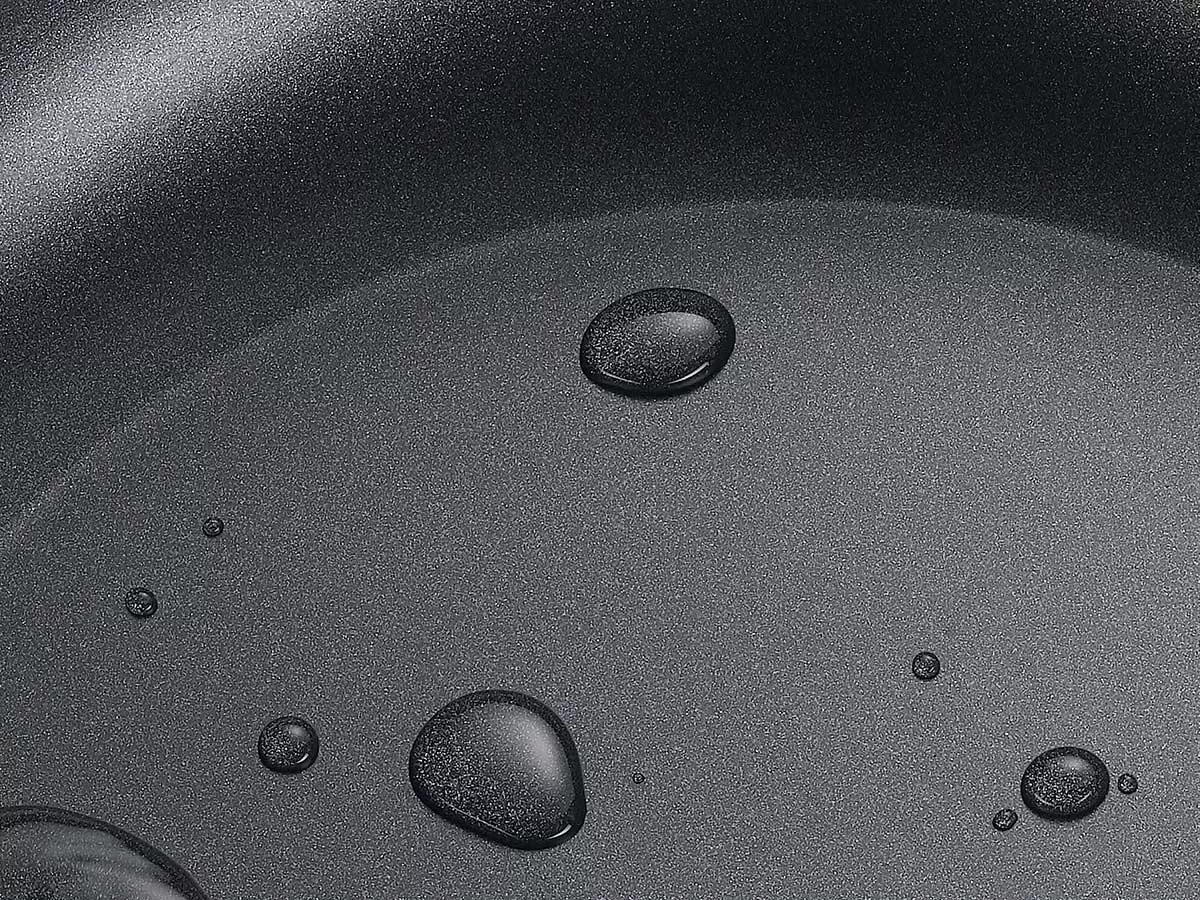Common Causes of Non-Stick Pan Coating Deterioration
Non-stick pans are a kitchen favorite, but they can lose their coating over time. Understanding the reasons behind this deterioration can help you take better care of your cookware.
Age and Wear
As non-stick pans age, their coatings naturally wear down. Even the best pans won’t last forever. Regular use can lead to a gradual loss of the non-stick surface, making it less effective over time.
Improper Cleaning Techniques
Using the wrong cleaning methods can damage the coating. Here are some common mistakes:
- Using metal utensils that scratch the surface.
- Cleaning with abrasive sponges that can wear down the coating.
- Dishwashing instead of hand washing, which can be too harsh.
High Heat Exposure
Cooking at high temperatures can cause the non-stick coating to break down. It’s best to stick to medium heat to keep your pans in good shape. Avoid overheating to extend their lifespan.
Use of Metal Utensils
Using metal utensils can scratch and damage the non-stick surface. Instead, opt for silicone, plastic, or wooden utensils to keep your pans safe.
Taking care of your non-stick pans is essential to keep them functioning well. Avoiding common mistakes can help you keep your non-stick pans slick and shiny.
Signs Your Non-Stick Pan Needs Replacement
When it comes to non-stick pans, knowing when to replace them is crucial for safe cooking. Here are some key signs to watch for:
Dark Discoloration
Dark spots or discoloration on your non-stick pan can indicate that it’s time for a replacement. If the surface looks burnt or has a buildup of residue, it may no longer be safe to use. Regular cleaning can help prevent this, but once it becomes severe, it’s best to get a new pan.
Deep Scratches
If you notice deep scratches on the surface, it’s a sign that the non-stick coating is damaged. Superficial scratches are common, but deep scratches can expose the metal underneath, which can be harmful. Always use non-stick-safe utensils to avoid this issue.
Peeling and Flaking
A non-stick coating that’s peeling, flaking, or chipping is a sure sign that your pan should be replaced. Once the coating starts to come off, it will only continue to deteriorate, affecting its non-stick properties and potentially leading to health concerns.
Warping
If your pan is warped, it can lead to uneven cooking and may not sit flat on the stove. This can cause food to cook unevenly and may even pose a safety risk. If you notice any warping, it’s time to consider a replacement.
Remember, taking care of your non-stick pans can extend their life, but eventually, all pans will need to be replaced. Keep an eye out for these signs to ensure safe and effective cooking!
Proper Care to Extend the Life of Non-Stick Pans
Taking care of your non-stick pans is essential to keep them in good shape for a long time. Here are some tips to help you maintain their quality:
Using Non-Stick Safe Utensils
- Always use utensils made of silicone, wood, or plastic. Metal utensils can scratch the surface, leading to damage.
- Avoid using sharp tools that can cut into the coating.
- Keep a set of non-stick safe utensils handy to prevent accidents.
Avoiding Abrasive Sponges
- Use soft sponges for cleaning your pans. Abrasive sponges can ruin the non-stick surface.
- Rinse your pan with warm water and a gentle dish soap after each use.
- For tough stains, soak the pan instead of scrubbing hard.
Hand Washing Only
- Always wash your non-stick pans by hand. Dishwashers can expose them to high heat and harsh detergents.
- Use a mild detergent and warm water to clean your pans.
- Dry them immediately to prevent water spots.
Proper Storage Techniques
- Avoid stacking your non-stick pans without protection. Use a dish towel or pan protector between them.
- Store them in a cool, dry place to prevent moisture buildup.
- Keep them away from direct sunlight to avoid fading.
Following these care tips can significantly extend the life of your non-stick pans, ensuring they remain safe and effective for cooking. Remember, proper care is key to longevity!
Mistakes That Accelerate Non-Stick Coating Loss
Non-stick pans are great for cooking, but certain mistakes can ruin their coating faster than you think. Here are some common errors to avoid:
Using Cooking Spray
Avoid using non-stick cooking sprays! These sprays can leave a sticky residue that builds up over time, making it hard to clean your pan. Instead, use a small amount of oil or butter to keep your food from sticking.
Overheating the Pan
Cooking at high temperatures can damage the non-stick coating. It’s best to stick to medium heat or lower. This helps keep the coating intact and prevents it from peeling off.
Stacking Pans Without Protection
When you stack non-stick pans without any protection, you risk scratching the coating. Always place a dish towel or a pan protector between pans to keep them safe from damage.
Submerging Hot Pan in Water
Putting a hot non-stick pan directly into cold water can cause thermal shock, which may warp the pan or damage the coating. Let the pan cool down before washing it.
Taking care of your non-stick pans is essential for their longevity. Proper care can extend their lifespan significantly.
By avoiding these mistakes, you can help keep your non-stick pans in great shape for a long time!
Can Non-Stick Pans Be Recoated?
Manufacturer Recoating Services
Many manufacturers offer recoating services for non-stick pans. If your pan is still in good shape but the coating is wearing off, this can be a viable option. However, it’s essential to check if your specific brand provides this service.
Cost vs. Benefit Analysis
Before deciding to recoat, consider the costs involved. Sometimes, it may be more economical to buy a new pan rather than pay for recoating. Here’s a quick comparison:
| Option | Estimated Cost | Pros | Cons |
|---|---|---|---|
| Recoating | $20 - $50 | Extends life of the pan | May not restore full non-stick properties |
| Buying New | $30 - $100 | New technology and materials | Initial cost may be higher |
DIY Recoating Methods
If you’re feeling adventurous, there are some DIY methods to recoat your non-stick pans. Here are a few steps you can try:
- Clean the pan thoroughly to remove any residue.
- Apply a non-stick spray or oil evenly across the surface.
- Heat the pan on low for a few minutes to set the coating.
Remember, while DIY methods can help, they may not be as effective as professional recoating. Always prioritize safety and health when using cookware.
Choosing High-Quality Non-Stick Pans
When it comes to selecting a non-stick pan, quality matters. A well-made non-stick pan typically has multiple layers of coating and a sturdy body. Here are some key points to consider:
Materials and Construction
- Look for pans made from durable materials like stainless steel.
- Ensure the pan has several layers of non-stick coating for better performance.
- Check if the pan is oven-safe for added versatility.
Layering of Coatings
- Higher-quality pans often feature multiple layers of non-stick coating, which helps them last longer.
- A single-layer coating may wear out quickly, leading to sticking issues.
- Consider pans that are tested and rated for their non-stick properties.
Price vs. Longevity
- Investing in a high-quality non-stick pan may cost more upfront, but it can save you money in the long run.
- Cheaper pans often need to be replaced more frequently due to wear and tear.
- A good rule of thumb is to choose pans that come with a warranty, indicating confidence in their durability.
Choosing the right non-stick pan can make cooking easier and more enjoyable. A quality pan will not only perform better but also last longer, reducing the need for frequent replacements.
By focusing on these aspects, you can ensure that your non-stick pan will serve you well for years to come. Remember, a well-made non-stick pan is an investment in your cooking experience!
Conclusion
In summary, non-stick pans are great for cooking, but they don’t last forever. Over time, their coating can wear down due to age, improper care, and even the materials they’re made from. To keep your non-stick pan in good shape, use the right utensils, avoid stacking them, and clean them gently. If you notice peeling or deep scratches, it’s best to replace the pan. By taking care of your non-stick cookware, you can enjoy delicious meals for years to come.









